Swing trading capitalizes on short to medium-term price fluctuations. However, financial markets can shift quickly and unexpectedly. As such, without a well-structured plan, you risk incurring losses that exceed your tolerance. This guide explores essential risk management strategies when becoming a swing trader. We discuss how traders can navigate market volatility and maintain emotional discipline. This ensures your swing trading endeavors get off to the right start.
Here are some key points when managing risks in swing trading:Swing Trade Risk Management – Key Takeaways
What is a Swing Trade?
A swing trader aims to capture an asset’s short to medium-term price movements. This strategy derives its name from the concept of ‘swings’ in price trends – which are essentially oscillations between high and low values.
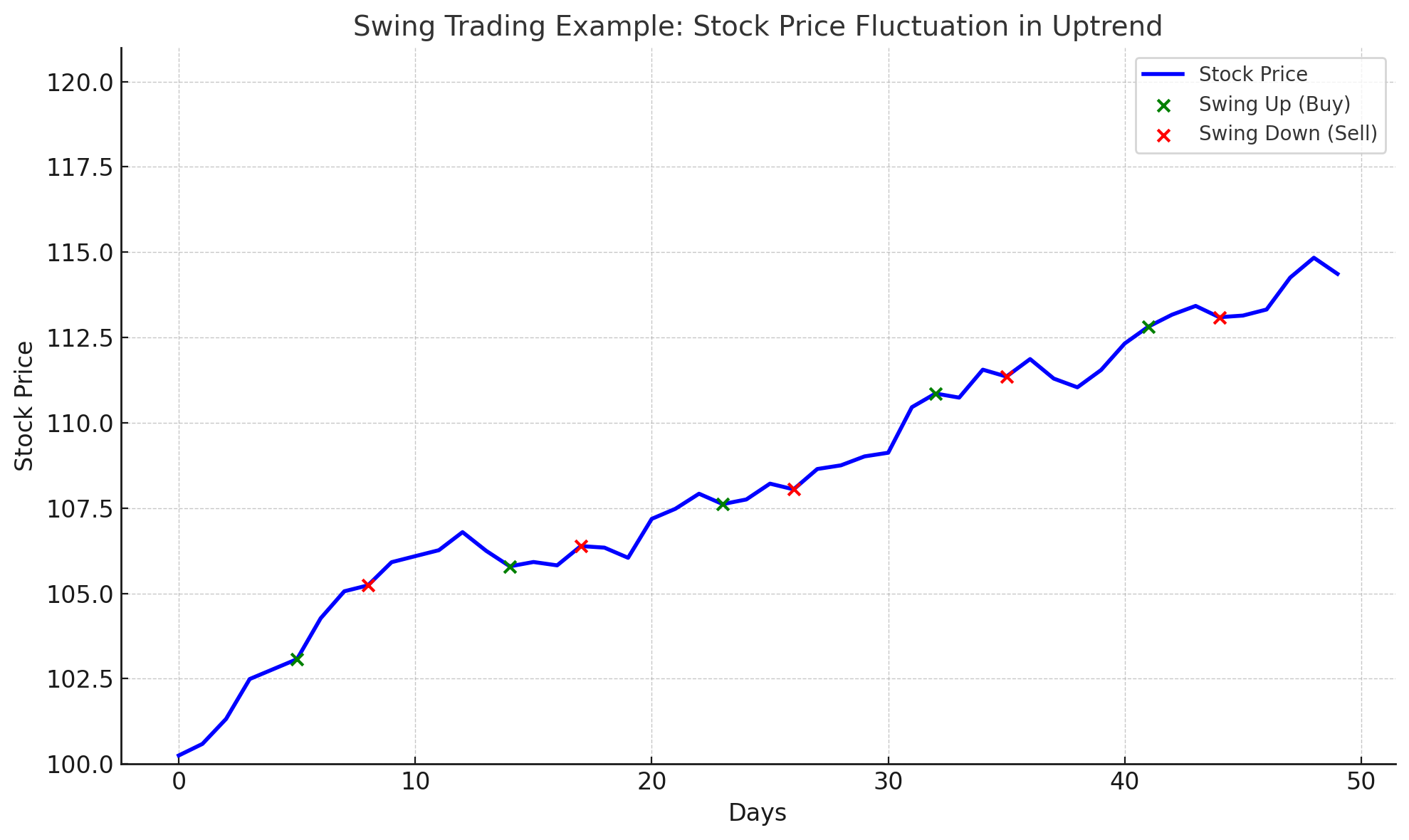
Swing traders target these swings to find optimal entry/exit points. They rely on technical indicators to predict the price action. Typically, swing traders hold positions for several days or weeks.
For example, in the stock chart above:
- Swing traders would aim to enter a position at the green points – for instance, at around $103.
- They will hold the position until the price goes up to $105, as in the example.
- During the next dip, the trader will open another position and sell when the price increases.
- This way, they capitalize on short-term trends within the broader uptrend from $100 to $120
This strategy allows you to profit from both upward and downward movements within the overall trend.
Types of Risk in Swing Trading
Like all strategies, swing trading requires risk management. This strategy holds positions for multiple days or weeks. This means it exposes traders to various risks.
The first step to managing potential losses is understanding where the risk lies.
Price Swings
While price swings can be positive for traders, it’s also the most obvious risk. Market risk arises when the asset’s price moves unfavorably against your position. This could be triggered by news events or the broader economy. Unsurprisingly, sudden and unexpected market shifts can quickly lead to losses.
For example, imagine a trader buys a stock at $50 – expecting it to rise to $60 based on technical analysis. However, due to an unexpected leadership change announcement, the stock drops to $30. If the trader didn’t have a stop-loss in place, they would suffer significant losses before exiting the position.
Liquidity Risk
Another common risk to consider is a lack of liquidity. An asset with high liquidity indicates that it has sufficient demand in the market. In other words, it can be easily traded and will likely have competitive spreads.
On the other hand, weak liquid assets may experience difficulty finding buyers or sellers at the desired price.

They might also have a wider bid-ask spread. If an asset is not liquid enough, traders may face slippage. This means they can’t execute a trade at the planned price. For example, if a trader tries to sell a low-liquid stock, they may have to accept a lower price than anticipated. This reduces potential profits or increases losses.
Leverage Risk
Leverage risk is particularly important for swing traders who use margin facilities. Leverage allows traders to open larger positions with smaller capital. This is effectively done by borrowing funds from the broker. However, this capital boost amplifies both gains and losses.
Note that brokers also demand collateral. And, if the market moves against the prediction, they may face a margin call. This is when the broker requires additional funds to sustain the leveraged position. Failing to fulfill the margin call could lead to the position’s liquidation. Meaning, the broker will close the trade to recover borrowed funds.
For instance:
- If you use a leverage of 10x and have $1,000 in your account – your position will be amplified to $10,000. The $1,000 is known as the initial margin.
- If the asset price drops by just 5%, the $500 loss would amount to 50% of your margin balance.
- Since you’ve borrowed funds, the broker may issue a margin call. Meaning, you’d need to deposit more capital into your account to maintain the leveraged position.
- If the asset price continues to drop and you don’t fulfill the margin call, your broker could liquidate the position.
This means the position will be automatically closed, potentially wiping out your remaining capital. What’s more, if the liquidation doesn’t cover the losses, your account balance will turn negative. Without strict risk controls like stop-loss orders, leverage can quickly lead to large, irrecoverable losses.
Emotional Risk
An overlooked risk in swing trading is the emotional factor. Human emotions – particularly fear, impatience, and greed – can significantly impact trading decisions. For instance, a trader may keep the position open longer than they should.
This could be done with the hope that the price will eventually recover. Or, a trader might sell too early out of fear of losing profits, missing out on further gains. Discipline is critical in swing trading, as emotional judgments often lead to poor risk management.
Risk Management for Swing Traders
While you can’t avoid risk in trading, you can take measures to limit your exposure. Here are some vital steps to implement as a swing trader.
Method 1: Position Sizing
In simple terms, position sizing determines how much capital you allocate to each trade. This depends on your risk appetite and the trade setup. Proper sizing ensures that no single losing position significantly damages your trading account.
There are several ways to approach position sizing.
Fixed Dollar Risk Method
In this method, you decide on a fixed dollar amount you’ll risk on each trade. The position size is determined based on that risk and the difference between your entry and stop-loss prices.
- For instance, you decide to risk $100 on a stock trade.
- Your position size determines how many shares you buy.
- Suppose the stock you want to buy costs $50 a share.
- You want to limit your losses to $48 a share.
- Next, determine the difference between the entry and stop-loss prices – say $2 per share ($50 – $48).
- Divide your risk by the stop-loss distance.
- In this example, it would be $100/$2 = 50 shares.
In this case, you would buy 50 shares at $50 each – for a total position value of $2,500. You also set a stop loss at $2,400 (50 x $48 per share). This brings the total risk to $100 for this trade – as calculated above. Some brokers allow fractional shares, which can help you get closer to your exact risk amount.
When you’re opening multiple positions, consider the total risk involved. Additionally, you should also factor in the trading fees when calculating risk.
Percentage Risk Method
This method involves staking a fixed portion of your total balance on each trade. This helps you maintain a consistent risk spectrum across trades.
For instance:
- Suppose you have a fund balance of $50,000.
- You’re willing to risk 1% for a single trade.
- This means the maximum stake per trade is $500.
Then, you can use the formula discussed above to calculate the position sizing.
Leverage-Based Method
As mentioned, leverage lets you open a position with more money than the account balance permits. However, your position sizing formula must account for the margin required and the increased risk.
Let’s consider a more detailed scenario:
- Suppose you have an account balance of $5,000.
- You apply leverage of 10x – bringing your potential position size to $50,000.
- Let’s say you’re trading an asset priced at $10 per unit.
With $50,000 of buying power, you can purchase up to 5000 units ($50,000/10).
Method 2: Setting Stop-Loss Orders
A stop-loss is a preset order to sell an asset when it reaches a specific price point. Its primary purpose is to restrict extended losses on a trade. If the market moves against you, the stop-loss ensures the trade is closed before these losses become too large.
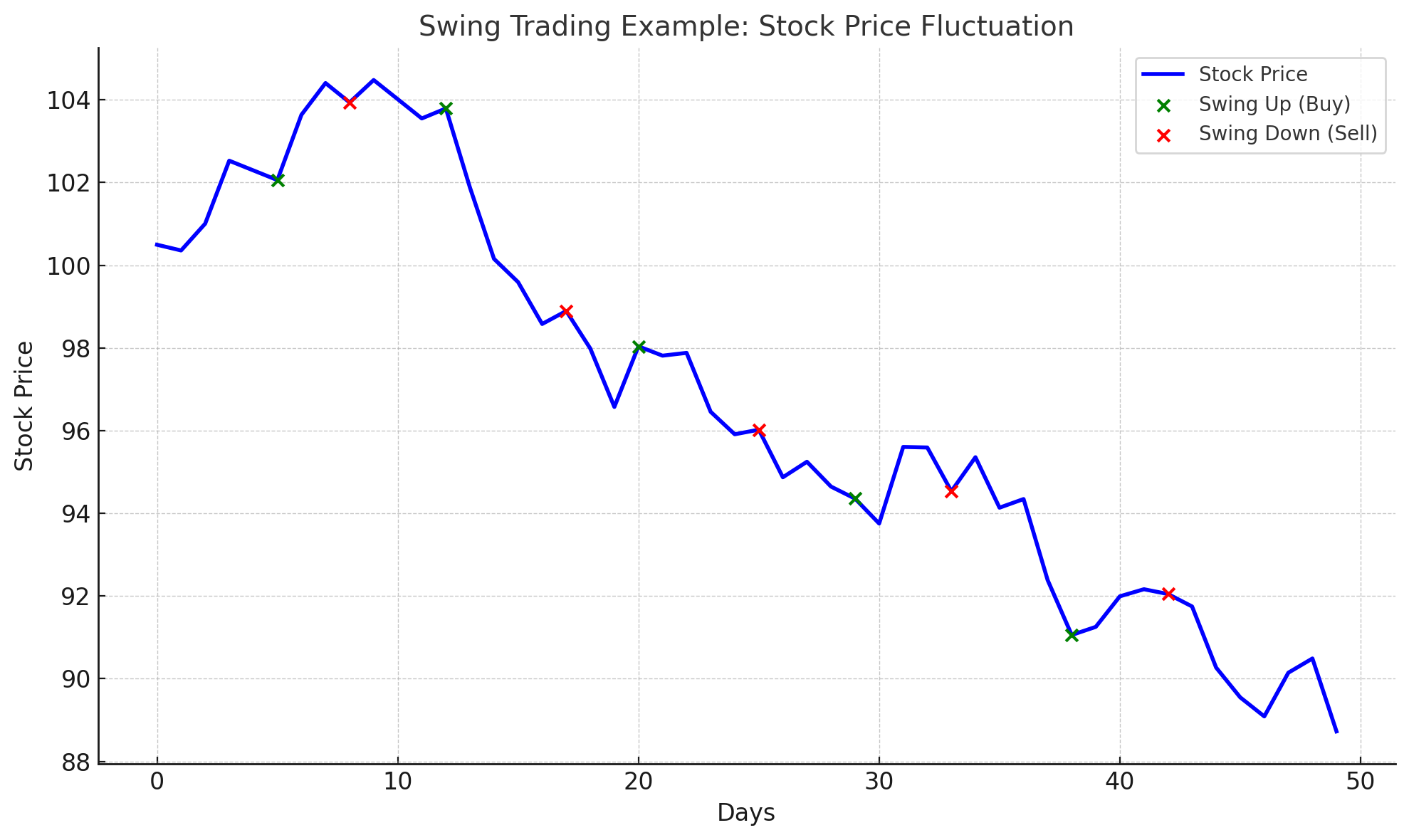
Stop-loss orders furnish a safety net for swing traders. This prevents emotionally influenced decisions and helps traders stick to their trading plan. Additionally, you won’t need to monitor trades constantly. Once the stop-loss is set, the order will be automatically executed.
Types of Stop-Loss Orders
The two most commonly used stop-loss orders are ‘fixed’ and ‘trailing’.
Fixed Stop-Loss
A fixed stop-loss order is positioned at a specific price level below or above your entry point. This depends on whether you’re long (below) or short (above) on the asset.
Once the market price hits this level, the order triggers, and your position closes automatically.
For instance:
- Let’s say you buy a stock at $100, expecting the price to increase.
- You determine the maximum loss you’ll take is 5%.
- So, you place a fixed stop-loss order at $95.
- If the stock’s price falls to $95, the stop-loss will sell your position, limiting your loss to that 5%.
Fixed stop-loss orders clearly define the amount of risk you take. However, the downside is that it could trigger an exit due to market fluctuations, and the price might recover afterward. This is common when trading highly volatile markets, such as cryptocurrencies and exotic forex pairs.
Trailing Stop-Loss
A trailing stop-loss order adapts to the asset’s price action. In a long swing position, as the asset’s price increases – the stop-loss level moves up to lock in profits. However, if the asset’s price moves against you, the trailing stop-loss does not adjust downward, protecting your capital.
For example:
- Let’s say you buy a stock at $100 with a trailing stop-loss set 5% below the market price.
- When the stock rises to $110, the trailing stop-loss moves to $104.50 (5% below the new high of $110).
- If the stock price drops to $104.50, your position will be exited, locking in your gains.
The main advantage is that the order shields profits as long as the market is favorable to you. It dynamically adjusts without requiring manual intervention. However, as with the fixed stop-loss, a sudden shift might trigger the order. This way, you potentially exit a position prematurely.
Finding Stop-Loss Levels
Picking the right stop-loss level is crucial for staying in a profitable swing trade. If it’s too close to your entry point – then it might trigger due to minor fluctuations. On the contrary, placing it too wide can lead to unnecessary exposure and more considerable losses.
Here are a few tools to find stop-loss levels for swing trades.
Support and Resistance
Support is a price level where an asset tends to stop falling. This is because buyers step in – creating demand and keeping the price from dropping lower.
Resistance is where selling pressure increases, stopping the price from rising. Swing traders use technical indicators to find these levels.
For instance:
- Suppose you’re going long on a stock with a support level of $50. You buy this stock above this price at around $51.
- You set your stop-loss just below that support, perhaps at $49.
- The reasoning is that if the stock breaks below support, it’s likely to continue declining. As such, you want to exit before larger losses occur.
- Similarly, for a short-selling position, the stop-loss would be placed above the resistance level.
You can also try to find support and resistance zones rather than exact prices.
Risk-to-Reward Ratios
You can also use a risk-to-reward ratio when setting a stop-loss. This dictates how much you stand to gain compared to the amount risked. A common ratio is 1:3. Meaning for every $1 risked, the potential reward should be $3.
For instance:
- If you’re targeting a price increase from $50 to $65 – this gives you a $15 potential profit.
- You set your stop loss at $45 – a potential loss of $5.
- So, you’re willing to risk $5 to gain $15, which brings your risk-reward ratio to 1:3.
When placing multiple swing trades, ensure each one has a favorable reward compared to the risk.
Diversification
Diversification is another popular strategy in managing risk for a swing trader. It simply means that you spread your risk across different assets or sectors. This way, you protect yourself from any significant loss that arises from a single trade.

Diversification can thereby help stabilize returns, balance portfolio volatility, and protect capital during unpredictable market movements. When applied to swing trading, you can diversify across multiple assets, such as stocks, commodities, forex, and cryptocurrencies. Within each asset class, you can trade different markets.
Diversifying Via Correlation
While diversification is about spreading investments, it’s crucial to understand the correlation. This refers to how different assets or sectors move in relation to each other.
For instance, if two assets are highly correlated, they tend to move in the same direction. Meaning, you’re not actually reducing the risk by investing in both.
Let’s elaborate.
- Positive Correlation – Positively correlated assets move in the same direction. For example, oil stocks and broader energy sector stocks are positively correlated. Higher oil prices generally increase energy companies’ profits, causing their stocks to rise. If oil prices fall, both might drop.
- Negative Correlation – Assets with negative correlation move in opposing directions. For instance, historically, stocks and bonds have been negatively correlated. During economic uncertainty, investors often move money from stocks to the safety of government bonds. So when stocks drop, bonds might rise.
- Non-Correlated Assets – Gold and certain currencies often move independently of stock market fluctuations. By including non-correlated assets, traders can mitigate the risk of a broad market downturn affecting all their holdings simultaneously.
To diversify effectively, you can use a combination of negative and non-correlated assets.
Diversifying Via Market Volatility
Swing traders capitalize on volatility. However, not all assets swing equally. Therefore, you can also diversify into volatile and stable investments.
- High-Volatility, High-Growth Assets – Some of the most volatile assets include emerging stocks and cryptocurrencies. They come with plenty of swing trading opportunities. However, there’s also the risk of sharp declines.
- Low-Volatility, Stable Assets – On the contrary, consider bonds, blue-chip stocks, and commodities for a more stable approach. With these assets, the duration of the swing might be longer.
One way to approach diversification as a swing trader is as follows:
- 20% in highly volatile assets – such as stocks in emerging markets and cryptocurrencies.
- 30% in relatively stable assets – such as stocks and bonds.
- 50% in non-correlated assets, like commodities.
By allocating a portion of your portfolio to stable assets – you can mitigate the impact of potential losses from volatile investments.
Account for Fees When Calculating Potential Losses
We mentioned that it’s important to consider fees when trading. Neglecting these charges can lead to unrealistic trade expectations. Swing trading often involves holding positions for several days to weeks. And during this time, fees can accumulate – eating into your profits.
Here are the most common fee types to consider when swing trading.
Brokerage Commissions
Many brokers charge a commission for each trade (buying and selling). While some brokers offer commission-free trading on specific assets like stocks, others may charge fees for options, futures, or international trades. The commission can also be fixed or percentage-based.
- Suppose a swing trader buys $10,000 worth of stock, and the broker charges a 1% commission per trade.
- When buying, the commission amounts to $100.
- Suppose the stock value increases to $20,000. Then, the commission when executing the sell order would be $200.
- In total, you would pay $300 for this trade.
This $300 needs to be factored into your profit calculations. Fees can quickly add up for small positions or frequent trades, cutting into profits.
Spread
Every asset has a buying and selling price on a brokerage platform. This price difference is the ‘spread’. This will be reduced from the net profit. As such, it plays a crucial role in risk management.
- For example, if a trader buys a stock at $50 (ask price) and can only sell it at $48 (bid price), the spread loss would be $2 per share.
- The spread can be wide when dealing with volatile assets. This is because there’s less liquidity in the market.
Ignoring the spread can lead to inaccurate performance assessments, particularly in volatile markets where spreads may widen.
Overnight Fees
Most brokers charge an overnight/swap fee when trading leveraged products. These fees vary based on the broker, asset, and existing interest rates. Suppose a trader holds a position worth $10,000 with an overnight fee of $5.
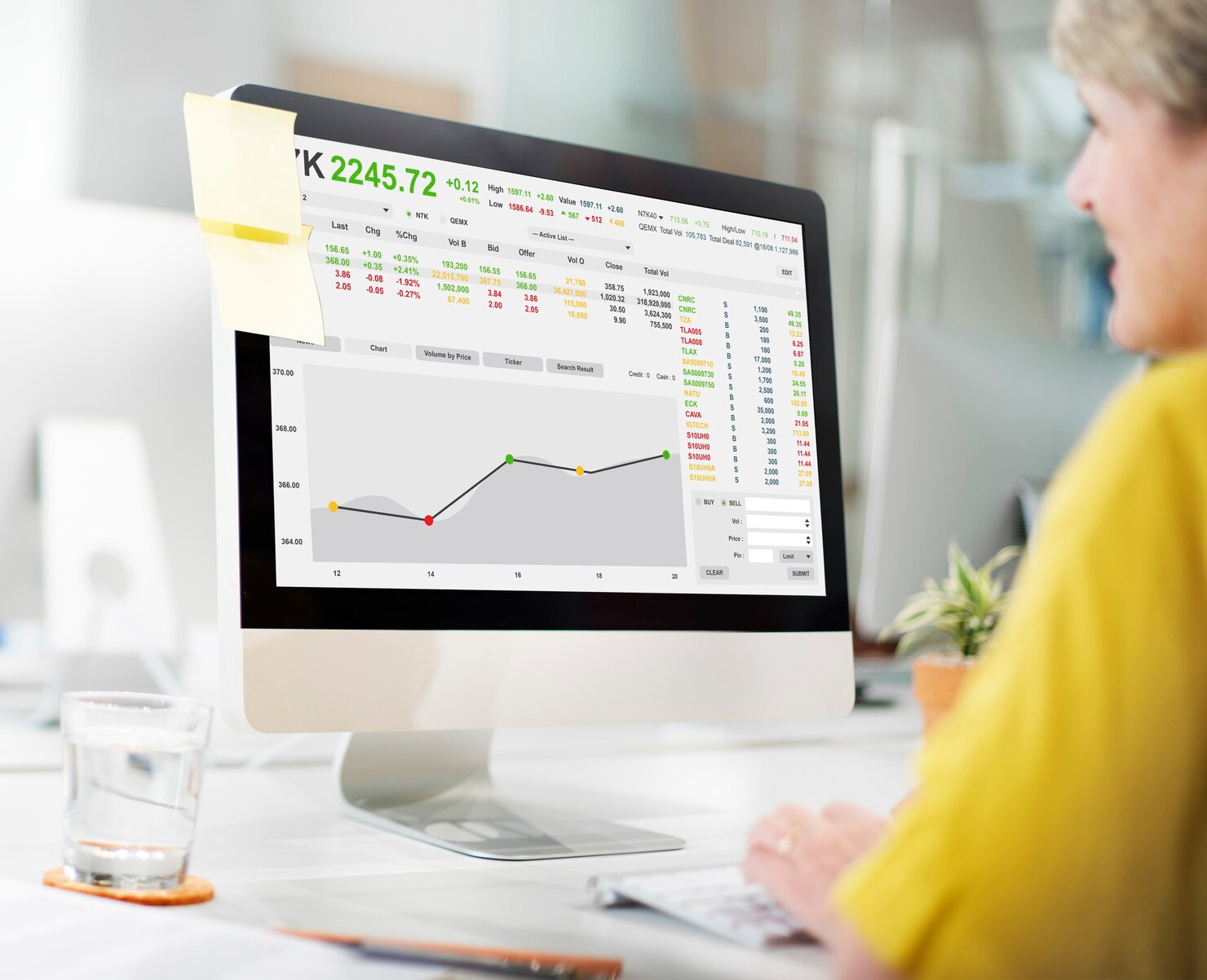
If they hold this position for a week, the total financing fee will amount to $35. These costs can quickly accumulate for longer-held positions.
Emotional Discipline For a Swing Trader
The swing trading strategy exposes a swing trader to market fluctuations that can trigger emotional reactions.
For instance:
- Imagine you buy a stock at $50, expecting it to rise to $60 within two weeks based on technical analysis.
- However, the stock drops to $45 halfway through the trade due to unforeseen news.
- You fear and panic – and exit the trade prematurely to avoid further losses.
- However, it turns out that the stock was within its normal volatility levels.
- In the following days, the stock recovers and reaches $60, as initially predicted.
This example emphasizes how emotional discipline can prevent impulsive decisions.
Below are some strategies that can help.
- Create a Clear Trading Plan – Outline entry and exit levels before opening a trade. Having a plan prevents emotional decisions during market fluctuations.
- Set Achievable Profit Targets – While bigger profits are tempting, you must set realistic targets based on your analysis. This helps you avoid holding onto a trade for too long and risking a reversal.
- Stick to Your Risk Management Strategy – Determine the fund percentage you’re ready to risk on each trade. Crucially, stay committed to it, regardless of market changes.
- Use Stop-Loss and Take-Profit Orders: Set automatic stop-losses and take-profit levels to exit trades according to your strategy.
- Avoid Constant Monitoring – Watching your trades is smart, but staying glued to the screen can trigger impulsive decisions. Instead, you can set alerts to be notified if the market changes drastically.
- Detach from Individual Trades – Every swing trade won’t be a winner. Focus on long-term performance rather than obsessing over individual positions.
- Keep Track of Your Trades – Documenting trades and emotional responses helps identify patterns and improves discipline over time.
Following a well-structured plan and sticking to risk management strategies will ensure you make rational trading decisions.
Top Brokers for Risk Management
A swing trader can pick any regulated broker that supports their chosen asset. However, important factors like commissions, spreads, leverage, and risk management tools should be considered.
Consider one of the brokers discussed below when making a decision.
1. AvaTrade – Regulated CFD Broker Offering Up to 400x Leverage
AvaTrade is a popular CFD broker supporting a variety of markets. Meaning, you can trade bullish and bearish markets without owning the underlying asset. Traders can deploy swing trading strategies for stocks, commodities, indices, cryptocurrencies, and options. AvaTrade supports various platforms, including MT4 and MT5. It also has a native platform with advanced features and indicators.
Not to mention automated trading tools like EAs. Additionally, you can engage in copy trading from experts via AvaSocial. AvaTrade also offers risk management tools like stop-loss orders and negative balance protection.

The broker also offers leverage of up to 400x, although this depends on the trader’s location (e.g. EU traders are capped at 30x). In terms of fees, AvaTrade offers competitive spreads and a 0% commission experience. However, an overnight trading premium is charged – which varies based on the asset and market conditions.
Pros: Cons:
2. ByBit – Manage Crypto Swing Trading With Advanced Order Types
Bybit caters exclusively to crypto traders. It offers a robust set of features for strategic trading and risk management. It comes with advanced charting tools and dozens of technical indicators – ensuring traders find the right entry and exit points. ByBit also has a wide array of order types – including trailing stop-losses.
ByBit also supports leverage of up to 200x. Moreover, ByBit offers futures and perpetual contracts along with spot trading. Bybit’s base commission is competitive, with spot trading fees of 0.10% for both makers and takers.

The fees are lower for derivatives – at 0.02% for makers and 0.055% for takers. Additionally, the platform offers commission discounts when trading higher volumes. You can also automate swing trading strategies via crypto trading bots. This way, the risk management process will be carried out without monitoring the market.
Pros: Cons:
3. eToro – Negative Balance Protection for Portfolios
eToro is another highly regulated platform for swing traders with licenses in multiple jurisdictions. It has a notable feature called negative balance protection. If sudden market shifts cause your portfolio’s value to turn negative – eToro will absorb the loss and reset your account to zero.
Additionally, eToro supports stop-loss and take-profit orders for more control over swing trades. eToro supports direct investment and CFD trading. You can access stocks, cryptocurrencies, commodities, ETFs, and indices. The broker also offers leverage of up to 30x.

eToro charges a flat commission of up to $2 for stock trading – depending on your location. ETFs are free to trade, whereas cryptocurrencies come with a 1% commission. CFDs are commission-free; however, you must pay fees when you keep swing trades open overnight. eToro is also known for its copy trading tool. This enables you to replicate the swing trading strategies of other users.
Pros: Cons:
4. Pepperstone – Leverage of Up to 500x Accessible to Professional Traders
Pepperstone is a great option for professional traders looking for high leverage. It offers up to 500x, whereas retail traders can get up to 30x. Moreover, the broker automatically closes losing positions if the account balance falls below the margin rate of 50%.
In terms of assets, Pepperstone supports over 1,200 financial instruments. This includes forex, stocks, commodities, ETFs, indices, and cryptocurrencies. The broker integrates with cTrader, TradingView, MT4, and MT5 – thereby giving you access to advanced analytical tools and risk-managing orders.
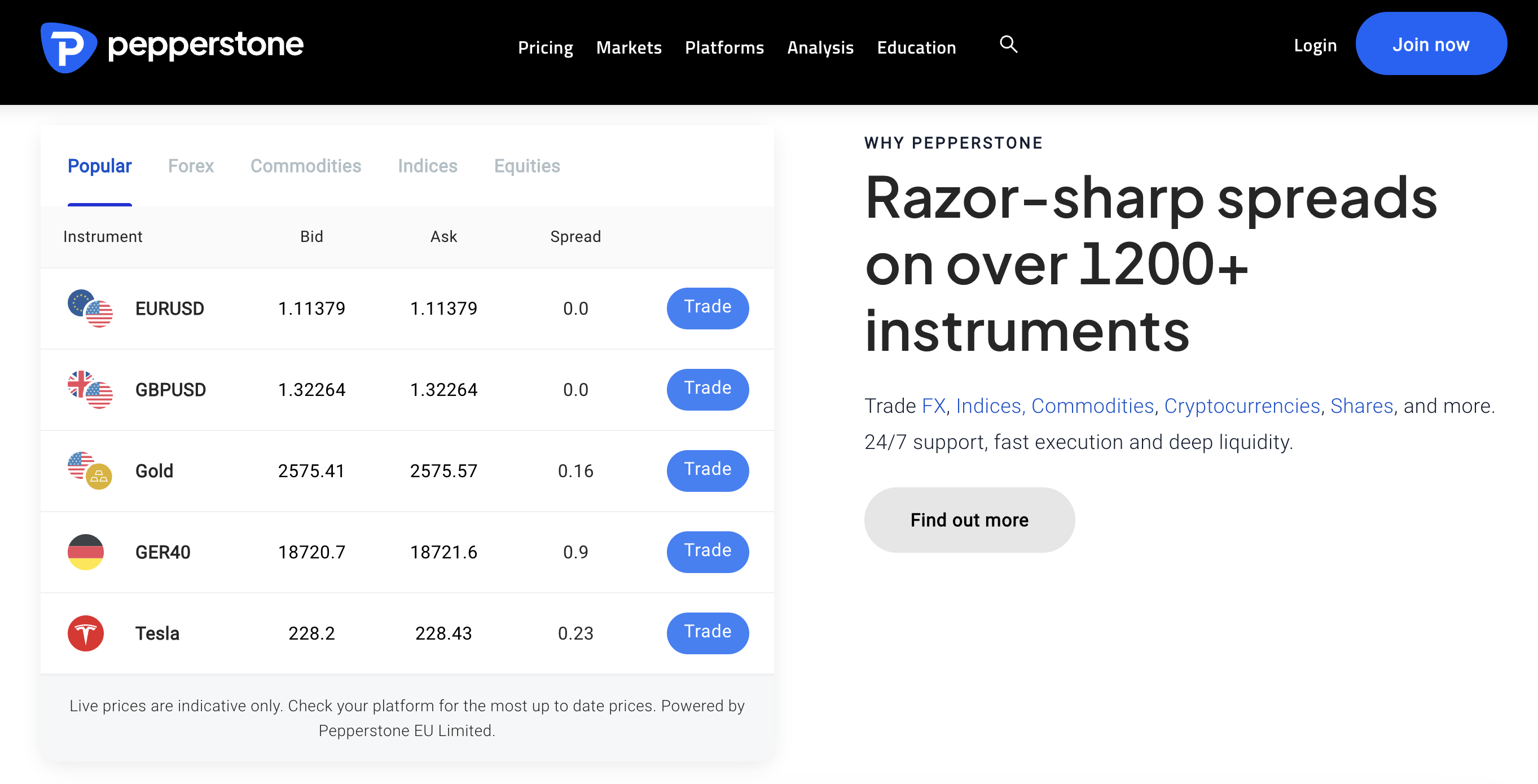
Pepperstone’s Razor account offers spreads from 0 pips – plus a commission of $3 per lot, per side. On the other hand, the Standard account charges no commission but has a variable spread. Pepperstone’s Active Trader program also offers discounted spreads based on trading volume. However, overnight fees are applicable for swing traders.
Pros: Cons:
5. NinjaTrader – Assess Account Risk Management with Trailing Max Drawdown
NinjaTrader is a leading futures trading platform for stocks, commodities, and cryptocurrencies. It comes with an ‘Advanced Trade Management’ feature. This includes predefined profit targets and personalized strategy templates. You can even create a custom stop-loss strategy for preventing risk.
Another top feature is the option to calculate the trailing max drawdown. It measures how much your portfolio declined from its peak before recovering. This helps you see the biggest loss you could face during trading. NinjaTrader supports end-of-day and real-time trailing max drawdown calculations.
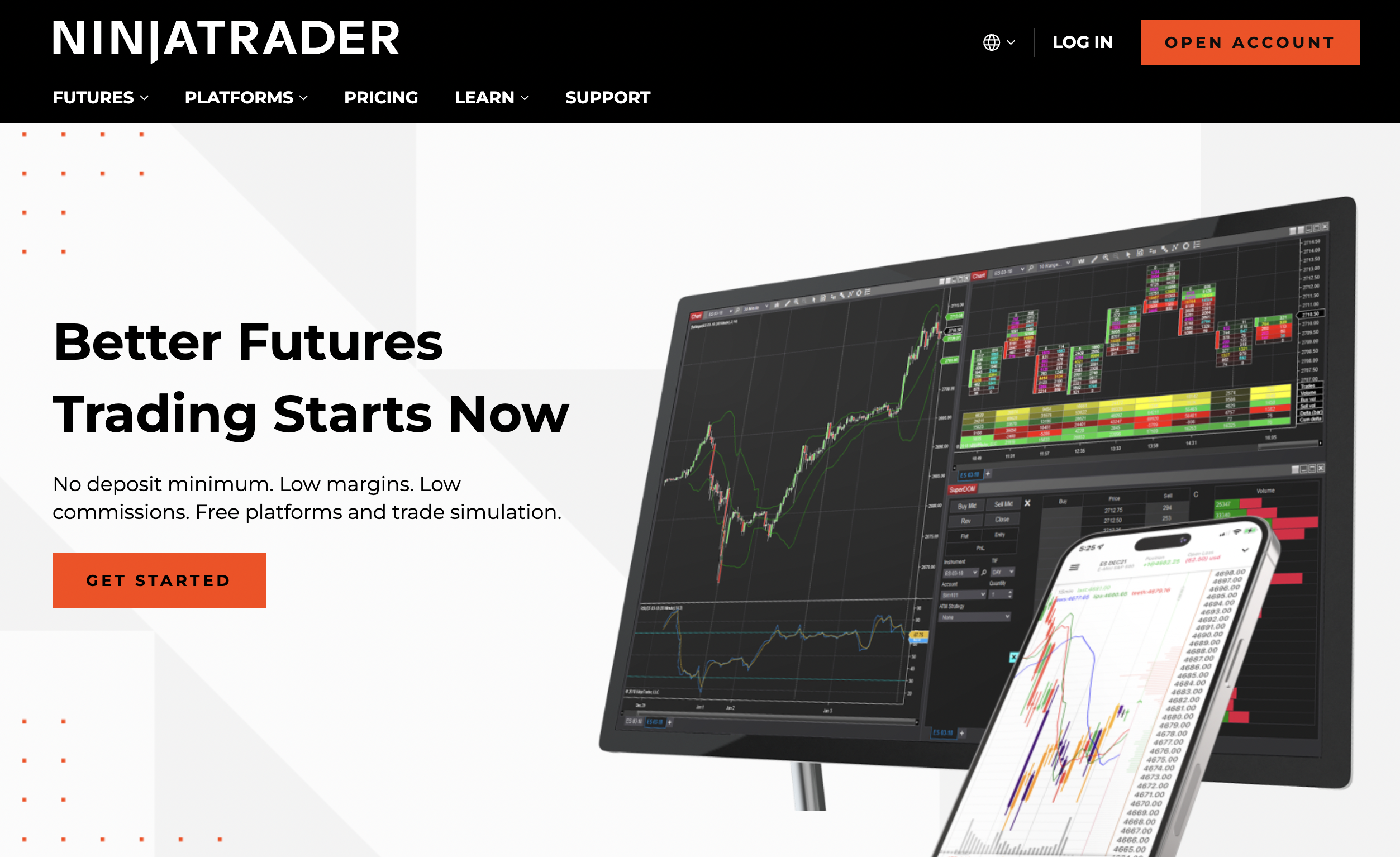
The broker offers three accounts with varying flat commissions – from $0.09 to $1.29. Moreover, overnight swing positions have a higher margin requirement than day trading. The specific overnight fees depend on market conditions. Users must also pay up to $50 after one margin call violation.
Pros: Cons:
Best Way to Automate Risk Management in Swing Trades
We’ve provided a comprehensive explanation of what is a swing trade and its related risks. While there are many ways to manage trading risk, planning and implementing them can be cumbersome. Not only do traders need to calculate risk for each position, but also monitor them. This is where the best trading bots come into play.
Algobot, an advanced trading bot, offers several key advantages for implementing effective risk control. To begin with, it automatically finds the right trading strategy based on the market. For instance, a swing strategy might be used for a short-term trend – or a scalping position for minor price action. With its AI integration, Algobot is constantly learning and improving its techniques.
It also executes positions based on your preferred risk level. It supports conservative, balanced, and aggressive approaches. This way, Algobot sets the optimal stop-loss levels. It can also manage multiple trades simultaneously. Since it follows an algorithm, human error and impulsive decisions are eliminated.
Algobot was tested for over three years to enhance its risk management strategies. It has gained a life cycle win rate of over 81%. Meaning that for every 1,000 trades it executes, 810 have resulted in a profitable position. This high win rate demonstrates the effectiveness of Algobot in minimizing risk for swing traders.
Conclusion
Swing trading offers significant profit opportunities. However, volatility and price fluctuations are both a blessing and a curse. While these facets create profit opportunities, they also expose traders to market, liquidity, and emotional risks.
As such, risk management is of extreme importance. Swing traders can protect their investments by managing position sizing, setting stop-losses, and maintaining emotional discipline. Additionally, they can use trading bots like Algobot to automate risk management processes.
FAQ
What is a swing trade?
In a swing trade, a swing trader held positions for a few days to weeks to profit from price trends. A swing Trader aims to profit from ‘swings’ in the market during this period.
Which assets are commonly traded in swing strategy?
A Swing trader can trade stocks, forex, cryptocurrencies, and commodities. A swing trader focuses on assets with enough volatility to offer profit opportunities over short time frames.
What are the major risks for a swing trader?
The major risks in swing trading for you as a swing trader include market volatility, overnight price gaps, and holding costs such as fees and interest rates. Additionally, emotional-decision making can also impact the position’s performance.
How to manage risk as a swing trader?
To manage risk in swing trading, you as a swing trader can use stop-loss orders and carefully monitor position sizes. Proper risk management also involves accounting for fees and setting achievable profit goals.








